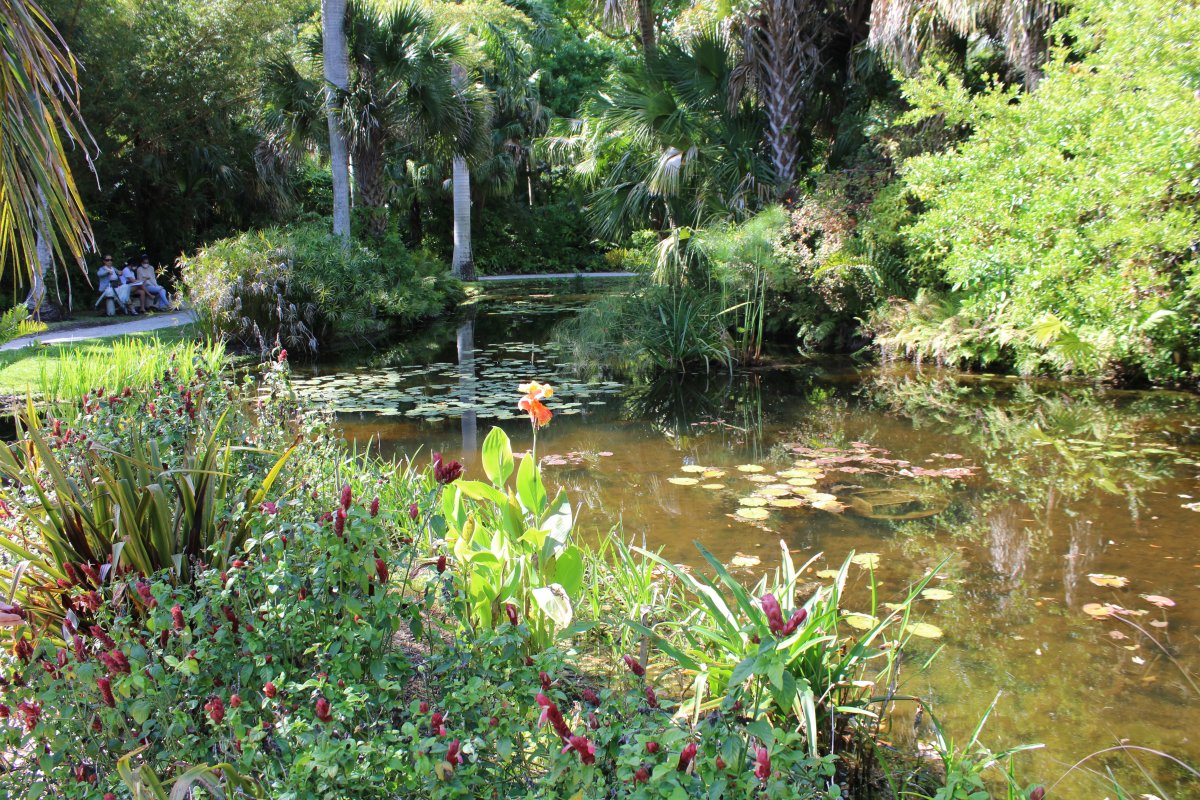March 11, 2021 - McKee Botanical Gardens
Today, we checked out the McKee Botanical Gardens in Vero Beach.
This is the entryway arch, or Pergola, constructed in 2001 on the site of the original McKee Jungle Gardens entrance.

The McKee Botanical Gardens has an interesting history, to me at least.
The area around the site of the Garden is a hammock. This vast subtropical ecosystem was a primeval landscape filled with magnificent stands of oaks, pines, palms and maples bound together with wild grape and Spanish moss. This particular parcel was purchased by land developers Arthur G. McKee and Waldo E. Sexton. Originally they intended to use it as a citrus grove, but then decided to keep it as they found it. Arthur McKee had the money thanks to a successful career in the iron and steel industry as an engineer and businessman and Waldo Sexton, a charismatic salesman, had the ideas. The property’s natural beauty was deemed too special in its native state to disturb so McKee and Sexton identified a new purpose for the land.
McKee and Sexton employed landscape architect William Lyman Phillips, from the esteemed firm of Frederick Law Olmsted, to design the basic infrastructure of streams, ponds and trails while they focused their efforts on assembling one of the most outstanding collections of waterlilies and orchids – augmenting native vegetation with ornamental plants and exotic specimens from around the world. They also brought in monkeys, key deer, macaws and animals from around the world to add to the jungle environment.
Waldo added at 3000-year-old, cypress stump he found at a friend’s sawmill and iron gates from Henry Flagler’s Whitehall estate. His crowning achievement at the garden was the Hall of Giants with pole and beam construction and cypress board to house a magnificent 38 ft mahogany table, the largest in the world. He also built the Spanish kitchen and adorned it with tiles and wrought iron adornments and lanterns.

In 1932, the McKee Jungle Gardens opened as a tourist attraction.
As time went on the Jungle Gardens became one of the more popular attractions on the Florida roadside attraction circuit. By the 1940’s, more than 100,000 tourists were visiting the Gardens each year, deeming it one of Florida’s earliest and most popular natural attractions. In 1941 McKee bought out Waldo Sexton.
The garden was closed during World War II except for use by the US Navy for jungle warfare training. It reopened after the war. I
In 1956, McKee died and his grandson, Arthur Latta, became the Jungle Gardens director.
In 1968, a campground and zoo with elephants and other large animals, including Doc the Dancing Bear were added.

By the late 1960's, the opening of Interstate 95 cut deeply into many of the now bypassed coastal tourist attractions. In 1971, the opening of Walt Disney World's Magic Kingdom and in 1973, Sea World in Orlando drew tourists to the center of the state and away from the coast. As central Florida developed in the 1970s, attendance at the Gardens waned and the family owned establishment was unable to compete with the lure of far bigger tourist attractions in central and south Florida. McKee Jungle Gardens closed in 1976 and was sold to condominium developers. All but 18 acres were developed. These 18 acres, once the heart of McKee Jungle Gardens, lay dormant for 20 years.

A group of community visionaries understood the imperative of preserving these 18-acres and in 1994, with the help of The Trust for Public Land, launched a fund-raising campaign to buy the land from the developer who was finalizing plans for a shopping center. With bare hands, basic tools and unimaginable heart, volunteers of every age cleared the trails to reveal once again the jungle’s treasures. Original plans were consulted. Plants were replanted, trails cleared, and other landscaping was done. The long looted and half decayed buildings on the property were restored. A gift shop, restaurant, and visitor center were added. November 18, 2001 marked the formal dedication of the saved, restored and newly named McKee Botanical Garden.

There are over 10,000 native and tropical plants to behold and one of Florida’s largest and most celebrated collections of water lilies. Several restored architectural treasures such as The Hall of Giants and Spanish Kitchen have been meticulously restored to Sexton’s original vision.
Miner boys trying to figure a way to climb this huge Dragon Tree.






Claude Monet would have liked the garden's Water Lilies.

Did you know that bamboo is a giant grass?






Approaching the Royal Palm Grove. This grove of Royal Palms was planted in 2002 to commorate one of the best loved features of the McKee Jungle Gardens: the Cathedral of Palms, which, in its prime, was a colossal stand of more than 300 royal palms planted in precise rows.
At up to 100 feet tall, the Royal Palms are among the tallest palms in the world.















Inside the Hall of Giants, in addition to information about the history of the botanical gardens, is this huge mahagony table weighting over 1,000 pounds and 35 feet long. Waldo Sexton had seen this 38-foot long piece of Phillipine Mahogany board at the Louisiana Purchase Exposition in 1903 and never forgot it. He found it 20 years later in a New York warehouse and bought it. He had it turned into a table.
The table had been sold when the Jungle Gardens closed in 1976 but the Gardens were able to somehow get it back.
The Hall of Giants was once a gathering place for social events like high school football banquets, dinner parties for the baseball Giants, corporate annual meetings, etc. 100 people could sit down at this table at one time and enjoy food prepared at the Spanish Kitchen where 100 steaks could be cooked at one time. Later the Hall of Giants was used as a gift shop.



